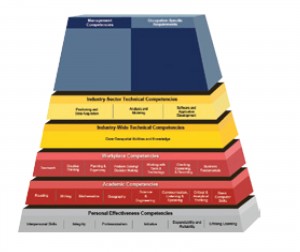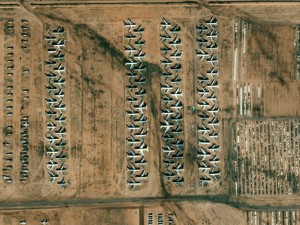DEFINING COMPETENCIES
A big advancement in defining the skills needed at the different phases of career advancements has been the Geospatial Technology Competency Model (GTCM). Geospatial has been numbered among industries with a set competency since it was identified as a high-growth industry by the U.S. Department of Labor back in 2003. See Figure 1.

FIGURE 1.
The Geospatial Technology Competency Model, also referred to as the Geospatial Education Pyramid
“The GTCM is widely known, and has good adoption in the two-year community college sector,” said DiBiase. “Among the four-year colleges and universities, it is known, but hasn’t had the same impact.” The GTCM can be used as an assessment to gauge the workforce needs and the gaps that university programs and other educators may want to address, as well as by students who are given the opportunity to assess their own knowledge and gaps. The National Geotech Center where the GTCM originated received a new round of funding by the National Science Foundation, and the key activity that they will deliver is the review and revision of the GTCM. “The GTCM addresses the educational elements that individuals need to have in order to enter this field,” said Dr. Jan Van Sickle, principal at Van Sickle LLC and professor at Penn State Online. “It also illustrates a multidisciplinary approach, but it has very little to do with technology; it has to do with fundamental knowledge.”
CONSIDERING GEOMATICS
Coordinate systems, cartography, geodesy, surveying, remote sensing, photogrammetry, GPS/GNSS, LiDAR, navigation, GIS—most practitioners don’t have the complete understanding of these related technologies. Conveying this broader view of geomatics science is the aim of the new Geomatics Engineering program within the College of Engineering and Applied Science at the University of Colorado Denver (UCD). The field of geomatics started more than 6,000 years ago with surveying, cartographic science, and geodesy, and then added photogrammetry, remote sensing, and GIS as these technologies emerged. There are only a few geomatics program in the United States, and this new program aims to fill an expertise gap by training geomatic engineers, researchers and scientists. “GIS is driving too much toward only GIS, and is disregarding a big part of the geomatics world,” said Dr. Apostol Panayotov, assistant research professor, College of Engineering and Applied Science, UCD. “We value what GIS did and continues to do, but they can’t change the world in their light. The new science arrived, and has become part of geomatics, but it’s not tearing apart the science of geomatics.” The new program retains a master in GIS and a GIS certification as well as a masters and Ph.D. in geomatics. Students can pick up their own specialization, and there are plans to address varied disciplines such as oiland gas, mining, environmental, and space exploration. “The program at UCD is following the geomatics program models of the programs at the University of Calgary and the University of New Brunswick, which are the oldest geomatics programs in North America,” said Panayotov. “Developing narrow specialists like GIS analysts and surveyors creates silos and limits their knowledge in only one area of geomatic science. The goal is to provide broader and comprehensive geospatial education, which will develop well educated geoscientists and professionals.” In Europe, there has never been the division between GIS and geomatics, but that’s the norm in the United States. In order to focus on the broader global opportunities, it’s important to factor in how the rest of the world learns these skills. There may be experts in individual disciplines in the United States, but if they don’t talk to others, there are deficiencies. Starting a new program from scratch requires resources from vendor partners and industry employers. The geomatics program at UCD has successfully launched, and has garnered a great deal of interest from prospective students. The program hopes to build on this momentum by connecting with funding sources that share this broader vision. Breaking down the traditional narrow geospatial tracks in order to train the next generation of geospatial generalists will help push broader adoption as well as technological innovation.
Why now, and why in Colorado? The Front Range—sometimes called “GIS Alley”—has one of the highest concentrations of geospatial government agencies and businesses in the world, and knowledgeable professionals are here to instruct. The demand is also high in Colorado, with greater connection to job opportunities for students. The program plans for completely online coursework in order to take advantage of the expertise of the local workforce while reaching out globally.
MOST MARKETABLE SKILLS
The typical approach is to categorize programs into groups such as photogrammetry, geodesy, surveying, and GIS, and these are considered separate and distinct categories. The reality is that all of these, and more, are part of an overarching geomatics science. The history of specialization in one tends to mean that you don’t have enough information on the others, and the broader picture is often left to be acquired on the job. “It is rare to nonexistent to have programs that address the pertinent areas of modern geospatial practice,” said Van Sickle. “It is typical for universities to be behind technological advancements in any field, and that’s partly the reason they don’t correlate well with current practice. There’s another more important reason, and that is that the geospatial work has changed fundamentally.” Most of the work that have objectives that benefit from geospatial solutions span across a range of tools and disciplines. While collaboration is more achievable through online means these days, there are many questions and answers along the way toward answering the overall objective. “How do you address the bigger problems if you’re just a surveyor, just a photogrammetrist or just a GIS person?” asked Van Sickle. “For instance, I’m not in favor of teaching a surveying course to young students today because I feel that I would be preparing them for unemployment. Surveying is still needed, but how much better to have someone who knows those principles, and photogrammetric principles, and geodetic principles, and GIS principles? That young person will have a glorious future with unending possibilities.” “If someone asks about a particular tool, my attitude is that teaching the principles involved to full comprehension is more important, because if a tool changes, and it inevitably will, they will be able to adapt and move on,” continued Van Sickle. “If I teach a particular tool, and they don’t understand the principles, then they can’t adapt, and they will quickly become obsolete.”
DYNAMIC TECHNOLOGY EVOLUTION
In the traditional GIS occupations, we think of professional and sophisticated desktop GIS software and image analysis tools as the norm. The trend in much of the software world has been away from this heavy-duty software toward apps that are focused on specific tasks. Along with the trend, there has been an explosion of those that are developing the applications. “Any geospatial program needs to have a substantial component of software design, programming, data management architecture, and database administration,” said Van Sickle. “The best way to prepare students for the real world is for them to come out of school with a robust geospatial understanding and programming skills.” “Esri now talks about ArcGIS as a platform—a foundation upon which users build custom applications that address their organizations’ needs,” said DiBiase. “This creates a challenge for the education sector, because not many academic programs are preparing students for application development opportunities.” While there is a never-ending battle to provide students with the technical competencies that they need, The Chronicle of Higher Education released a survey on the role of higher education in career development, surveying more than 700 employers about what they found lacking in the preparation of recent college graduates, including scientific and technical fields. They reported that skills like problem solving and the ability to manage multiple priorities, and communication skills were most lacking. Many employers rated these “foundational competencies” at least as important as technical skills. “In the rush to keep up with the expanding technology ecosystem, my worry is that we may neglect some of these foundational competencies that employers say are the most important,” said DiBiase. “Educators need to strike a balance between technical competencies with the equally important foundational competencies like communication and problem solving skills and business fundamentals. Weak foundational competencies combined with a lack of job experience put recent graduates at a real disadvantage in the geospatial job market.” The failure of higher education to ensure marketable skills and to balance the skills with specialized discipline-specific competencies is being addressed through an increasing emphasis on internships with workplace experience as part of the formal education process.
FLEXIBLE OPTIONS
There are formal and informal sides to all education today. Looking at the formal side, there are a number of two and four-year programs, and graduate school. The post-baccalaureate and practice-oriented programs, such as certification in specific software tools, are also seeing great growth, with working adult professionals out to advance their careers. There is also a large uncoordinated movement for volunteered geographic education, where individuals pursue their own interests. There is a real drive for most technology practitioners to pursue an education outside of the formal education process. If you look at YouTube for tutorial videos, you find a broad array of videos that are focused on teaching geospatial concepts or software functionality. Similarly, there are also massive open online courses (MOOCs) where university professors open up their coursework for free to a broad audience. Today’s practitioners are teaching themselves through these volunteered resources, as well as augmenting their education through more flexible online study options. “It’s a gratifying time for me, having started online learning at Penn State back in 1998,” said DiBiase. “There was quite a backlash from those who felt that it would cheapen the quality of a university education, but not many think that anymore. Most online education consumers have the same expectation of learning as face-to-face learning, with the added value to study in the time and place of your choosing. The potential to get a good education online is every bit as good as in a classroom, given teachers who care and know what they’re doing.”
A Sampling of Online GIS
Certificates and Masters Programs
American Sentinel University
http://www.americansentinel.edu/
Colorado State University
http://www.online.colostate.edu
Delta State University
http://www.deltastate.edu/college-of-arts-and-sciences/
biological-and-physical-sciences/mas-git/
Elmhurst College
http://public.elmhurst.edu/adult/gis
Esri Virtual Campus
http://training.esri.com/gateway/index.cfm
Birkbeck University of London,UK
http://www.bbk.ac.uk/gisc/index_html
Fresno State
http://www.fresnostate.edu/cge/giscert/
Johns Hopkins University
http://advanced.jhu.edu/academic/environmental/gis/
Northwest Missouri
http://www.nwmissouri.edu/socialsciences/msgis/index.htm
Penn State
http://www.worldcampus.psu.edu/GISCertificate.shtml
Ryerson University, Toronto, Canada
http://ce-online.ryerson.ca/ce/default.aspx?id=2584
Salisbury University
http://www.salisbury.edu/geography/msgism/index.html
UNIGIS International
http://www.unigis.org/
University of Colorado, Denver
http://bit.ly/1lqm4RC
University of Denver
http://universitycollege.du.edu/gis/degree/certificate/geographic-
information-systems-online/degreeid/31#courses
University of North Dakota
http://distance.und.edu/degree/?id=geoinfoscience2
University of Redlands
http://www.redlands.edu/academics/school-of-business/1231.aspx
University of Southern California
http://gis.usc.edu/
University of Toronto
http://bit.ly/1emyqEO
University of Washington
http://www.outreach.washington.edu/pmpgis/
University of West Florida
http://uwf.edu/gisonline/
Vancouver Island University, Canada
http://www.viu.ca/adgisa/




